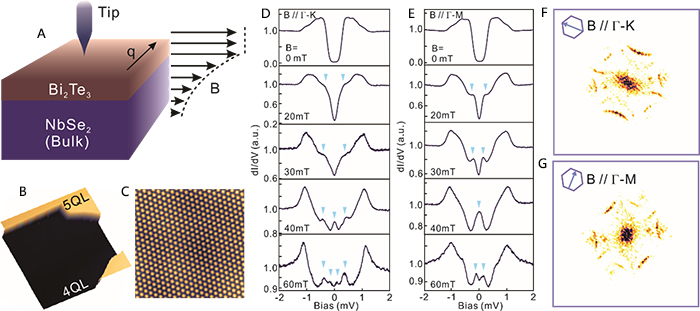Discovery of Segmented Fermi Surface in a Superconductor
Superconductivity is a long-standing research topic in physics. Superconductors have critical applications because of their unique properties like zero resistance and complete diamagnetism. When a superconductor is in the superconducting state, an energy gap will form at the Fermi level, so there is no Fermi surface in a superconductor. In 1965, theoretical physicists predicted that when the Cooper pair momentum in a superconductor is large enough, quasiparticles will be generated in the superconducting energy gap, thus forming a segmented Fermi surface. However, this prediction has not been confirmed experimentally for more than 50 years because when the Cooper pair momentum of conventional superconductors is large enough to create quasiparticles, the Cooper pair itself will break up and lose superconductivity.
Here, we discover the segmented Fermi surfaces in the topological insulator/superconductor heterostructures by using ultra-low temperature scanning tunneling microscopy (STM) equipped with a vector magnetic field. Via molecular beam epitaxy, a 4-layer thick film of the topological insulator Bi2Te3 is precisely grown on the surface of the superconductor NbSe2, the existence of uniform topological surface states and superconducting energy gaps are corroborated on the surface of this system (Fig. 1 A-C). By applying in-plane magnetic fields of different magnitudes and orientations, the abundant quasiparticle excitations are generated in the superconducting energy gap (Fig. 1 D and E), which heralds the gradual generation of segmented Fermi surfaces in superconductors. Using quasiparticle interference techniques, standing waves created by the scattering within the Fermi surface were detected in real space, and the generation of the Fermi surface at zero energy was further confirmed by Fourier transform. The shape and orientation of the Fermi surface can be regulated by the strength and direction of the applied magnetic field (Fig. 1 F and G).
This work innovatively solves experimental difficulties by using the special characteristics of topological insulator/superconductor heterostructures, and experimentally observes the segmented Fermi surface predicted by theory more than 50 years ago for the first time. It finds that the shape and size of this Fermi surface can be adjusted by the direction and magnitude of the magnetic field and can also modulate topology to build new topological superconductors. Our results open a new method to regulate the states of matter.
The relevant work was published in Science, 374 (2021) 1381.

Fig. 1. (A) Schematic diagram of a Bi2Te3/NbSe2 superconducting heterostructure; (B) Morphology of a high quality Bi2Te3 film grown on NbSe2; (C) Atomic resolution image of Bi2Te3 film; (D), (E) Signal from quasiparticles gradual increase in in the tunneling spectrum under the in-plane magnetic fields of different magnitudes and orientations; (F), (G) Segmented Fermi surfaces that varies with the direction of the magnetic field arise in the quasiparticle interference patterns.